Musik And Dance In Jainism
Having come to Jainism via Theravada Buddhism, a creed that leaving aside the
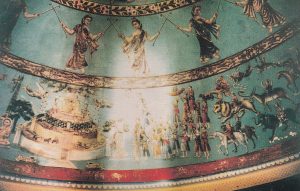 monotonous chanting of the monks – permits of no music in its temples. And as in my readings about Jainism I have never come across a comprehensive evaluation of Jaina music, I concluded that there was none.
monotonous chanting of the monks – permits of no music in its temples. And as in my readings about Jainism I have never come across a comprehensive evaluation of Jaina music, I concluded that there was none.
Does not Mahavira advise his monks and nuns to stay away from places where sounds of musical instruments can be heard? “A monk or nun,” says he,” should not resolve to go where they will hear sounds of stringed instruments, kettle-drums etc.” (Acaranga Sutra 2, 11, 1)
Only after I submitted myself to the impulse of going to see Jainism instead of just
studying it from books. I discovered that there is Jaina music and, to my delighted surprise, not just a solemn kind of incantation as someone might expect. whose knowledge of Jainism is confined to having studied its doctrines, but that there exists in Jainism the artistic capacity of producing. not seldom on the spur of the moment, sonorous seas of sounds which at times reach hights of jubilation that stir the participants into stepping forward and dancing.
It woud need someone better versed in matters of music and dance than myself to put this aspect of the Jaina religion into a wider perspective. I must confine myself to the attempt of inducing my non-Jaina readers to go, hear and see for themselves.
They would not return disappointed. The best time, next to certain major ceremonies such as the consecration of a new idol, is in the early evening when the temple-rite of arati, a ceremonial adoration of the Jina with kindled wicks, is performed.
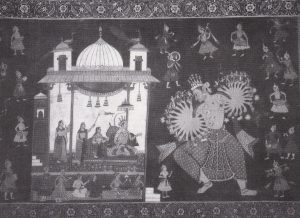 “We have”, to quote from a lecture by the late Kumari Parul Troliya. “little knowledge and record of contributions to music by Jainas. There are several creations like Gita Vitaraga in Sanskrit and Kannada along the lines of Jayadev’s ‘Gita Govinda’. (…)
“We have”, to quote from a lecture by the late Kumari Parul Troliya. “little knowledge and record of contributions to music by Jainas. There are several creations like Gita Vitaraga in Sanskrit and Kannada along the lines of Jayadev’s ‘Gita Govinda’. (…)
Jaina poets like Mahayogi Anandhan, Chindananda, Banarasi Das, Dyanstrai, and others, have created beautiful musical pieces in form of devotional lyrics, replete with indications of ragas. They are in no way inferior to Kabir, Meera or Surdas.(…)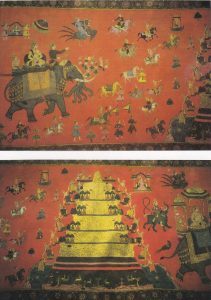
To conclude, the contribution of Jaina culture to Indian art, literature, music etc. is enormous but of which we, the Jainas ourselves, are not fully aware. Let’s be conscious of it, and enrich the rich heritage of ours.” (From Gomatavani, Vol. IV. No. 5. Shravanabelagola, 1989.)
Detail of a painted dome in a temple on Shatrunjaya Hill showing in the upper half a figurative dance indicative of the joyous mood associated with the mythical event pictured in the lower half (described above, pages 332/33). The photo 341 (left) was taken in the Mirpur Temple in 1992 (see pages 172-174). It shows that in Jainism tradition is still very much alive.
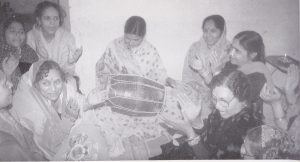 Jainism is far from being a cold or bloodless religion and there is a rich literature of praise and devotion to the fordmakers which, in the vernacular literatures of north and west India, reached a particularly impressive extent during the late medieval period. Dundas, 1992: 181.
Jainism is far from being a cold or bloodless religion and there is a rich literature of praise and devotion to the fordmakers which, in the vernacular literatures of north and west India, reached a particularly impressive extent during the late medieval period. Dundas, 1992: 181.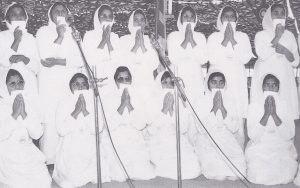
A Tirthankara is born. The news of it is greeted in the heavens with great joy. God Indra (also known as Shakra), arises from his spendidly jewelled throne and descends to earth accompanied by a retinue of celestial musicians. He, the king of gods, himself dancing to the playing of many instruments, approaches the newborn Tirthankara holding in his lower hands flowers and other offerings, while heavenly nymphs perform a welcoming dance on the palms of his hands
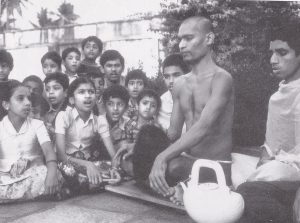 upper At the sight of Indra and the sound of music, the mother has placed the child on the lap of the king sitting next to her. Before long, both the parents fall into a spellbound sleep, so, without their noticing it, a maidservant takes the child and hands him up to Indra who, now sitting on his many-trunked elephant Airavata, rides to the foot of holy Mount Meru on the summit of which the newborn Tirthankara receives his first bath at the hands of the overjoyed gods and goddesses .
upper At the sight of Indra and the sound of music, the mother has placed the child on the lap of the king sitting next to her. Before long, both the parents fall into a spellbound sleep, so, without their noticing it, a maidservant takes the child and hands him up to Indra who, now sitting on his many-trunked elephant Airavata, rides to the foot of holy Mount Meru on the summit of which the newborn Tirthankara receives his first bath at the hands of the overjoyed gods and goddesses .
This done, the infant Jina is carried back to his parents, again to the sound of music and accompanied by dancing gods and celestial damsels.
These three photos show sequences from the twelve metre long painting on cloth kept in the Sana Gana Mandir at Karanja (see page 95). Interestingly, in Jaina pictorial art gods and heavenly musicians can be recognized by their nor having moustaches.
Evening time in a dharmashala pilgrims’ room annexed to the Ramtek Shantinatha Temple. A lady-pilgrim has invited her next-door neighbours into her temporary abode, demonstrating in that way her satisfaction with having had, on this day, the honour of serving food and drink to Acharya Vidhyasagar (see ill. 144).
Spontaneous music making and singing, carried on for hours; and saying farewell to each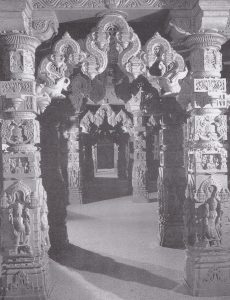 guest by handing her a small present mark the meritorious event.
guest by handing her a small present mark the meritorious event.
Religious songs, performed by a choir of samani nuns, enliven a general meeting of the India-wide Shvetambara Terapanth congregation, held near Ladnun in Rajasthan.
Two brahmacharis of the local Gurukula and a group of children have gathered in the court-yard of the Shravanabelagola Mangayi Basti to practise a hymn written and composed by a muni in which the statue of Bahubali is extolled to the skies. The re-occurring and fervently enunciated ‘himba the term for statue- lends the song a passionate flair.
It was evening, and we went to various bastis in the town of Shravana Belgola for darshan. We lingered long in Mangayi Basti listening to the evening prayers being recited by the children of the Shravana Belgola Jain Gurukula Seated in neat rows they sang hymns to the various Tirthankaras finishing with Gommateshvara stutih-a song in praise of Gommateshvara. (…)
From there we went to the matha where the evening arati wax in progress. A special prayer was being said in the honour of Goddess Kushmandini, the patron goddess of Shravana Belgola, who was dressed and decorated in jewels and flowers. The temple musicians played the shehnai and the drums to mark the end of another day.
Saryu Doshi Homage to Shravana Belgola, 1981: 32.
There appeared, too late for being mentioned in this chapter, a new book by Professor M.A. Dhaky entitled Arhat Parshva and Dharanendra Nexus, which contains a chapter on Jaina hymnic literature.
Interior of the Jaina Temple in Oxford Street, Leicester, UK, the first and so far (1998) the only Jaina Mandir in Europe. The inauguration took place in July 1988. Both Shvetambaras and Digarm- baras participated in the planning and building of the Centre which is open to all. “It aims to spread knowledge and sympathetic understanding of Jainism, and to promote the non-violent way of life.” A study room on the second floor is dedicated to Shrimad Rajachandra, the friend and teacher of Gandhi, see page 165. (Courtesy Jain Samal Europe, Leicester, UK)
